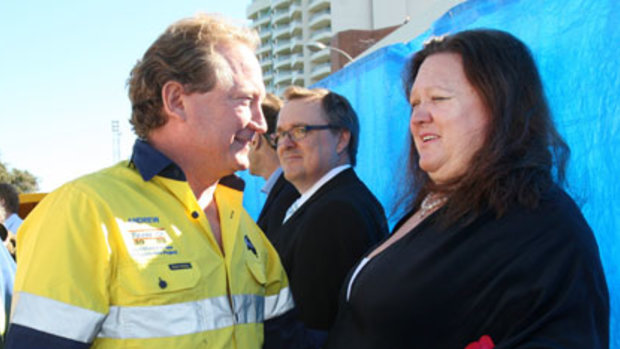A little vaccinated and overdosed on Panadol Birdie tells us that Jon Faine is on fire!
The reptiles in Melbourne, weaponised by the Murdoch tabloids and Sky News, ripped into Dan Andrews and Brett Sutton every bloody day for weeks on end, repeated the same questions a gazillion times hoping to trip them up, shouted at them, harangued and argued, stopped asking legitimate questions and instead made unfounded assertions and then demanded that mere rumours be proven untrue. How dare they?
Top private companies’ tax bill jumped 40pc

Income tax for Australia’s top 320 privately owned corporate groups jumped 40 per cent in the three years to 2018, in what the Tax Office says is vindication for its campaign to boost taxpayer compliance by close engagement.
The ATO’s tax avoidance taskforce has since broadened its compliance review to the top 500 private companies and the $195 billion of revenue that they report.
Iron ore magnates Gina Rinehart and Andrew Forrest at an anti-mining tax rally in Perth in June 2010.
Top 500 group members each have turnover of at least $350 million, net assets of $500 million or a mixture of the two, according to an ATO review released on Monday.
The groups typically are headed by a family member with a median age of 71 and comprise on average 31 trusts and companies.
Of the top 500, 52 groups or just over 10 per cent are in the ATO’s “Justified Trust” category, which frees them from all but routine monitoring for three years. Another 121 groups are working towards this JT rating.
The largest subset, 213 groups, are listed as engaged with the ATO but with no evidence to support a JT rating or not committed to the process, while six are listed as unwilling to work towards JT and 11 groups are not engaged.
“Pleasingly, we have found that most large private groups report correctly and meet their taxation obligations,” assistant commissioner Kasey Macfarlane said in a statement.
‘Significant’ rise
The ATO broadened its target group after noting that from 2015 to 2018, tax payable by the top 320 private groups jumped from $3.2 billion to $4.5 billion, according to the review.
That 40 per cent rise compared with a rise of only 14 per cent in tax payable by the next 180 largest private groups (which are now included in the top 500 group), against GDP growth of only 9.7 per cent.
The ATO says the rise in the top 320 was significant even after allowing for the impact of iron ore prices and surges in the property and construction industry.
While the ATO review does not name individuals, the difficulty in comparing tax rates is reflected in Australian Securities and Investments Commission filings by Gina Rinehart’s Hancock Prospecting, which reported income tax of $287 million on revenue of $2 billion for 2015, and $600 million income tax on gross revenue of $6 billion in 2018
While the ASIC accounts suggest Hancock’s tax bill more than doubled, the ATO’s tax transparency reports show a much smaller rise in tax payable, from $273 million to $352 million.
In addition, Hancock’s 2015 accounts also included $710 million in Minerals Resource Rent Tax payable in 2015, versus nil in 2018 after the MRRT was abolished, which means overall it paid less tax in 2018.
Andrew Forrest’s 36.25 per cent stake in Fortescue Metals provided his Minderoo Group with $45.9 million dividends in 2015, rising to $211.3 million in 2018 (and $1.6 billion last year), but these payouts were all fully franked.
“We have identified that large private groups often have lower levels of corporate governance, and in turn investment in tax governance starts from a lower base,” the ATO review said.
“In addition, large private groups are subject to less stringent (and hence less transparent) regulatory reporting requirements which is frequently complicated by opaque group structures and intra-group and related-party dealings that occur outside of tax consolidation.”
The review listed common tax risks, including property developers using special purpose trusts to transform taxable income into capital profits subject to capital gains tax; using trusts to divert company funds for private use or diverting income into self managed super funds; R&D rorts and transfer pricing.
The ATO’s tax avoidance taskforce has raised $13 billion in new assessments since it was set up in July 2016, on which it has collected $7.3 billion in cash.
CODA: ATO review of top 500 largest private companies improvestax transparency
The ATO has today published a report on its interim findings from the Top 500 tax performance program. The program, established under the Tax Avoidance Taskforce, encourages transparency from Australia's largest privately owned groups and helps the ATO to determine whether they are correctly meeting their income tax and GST obligations.
Neil Chenoweth is an investigative reporter for The Australian Financial Review. He is based in Sydney and has won multiple Walkley Awards. Connect with Neil on Twitter. Email Neil at nchenoweth@afr.com.au
